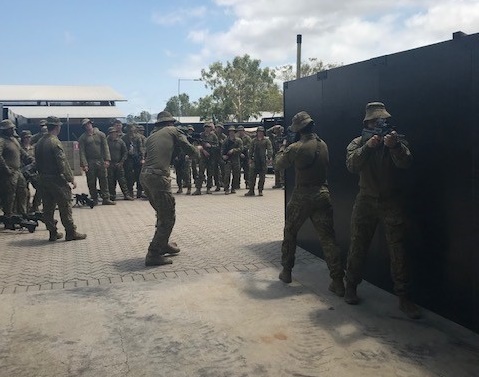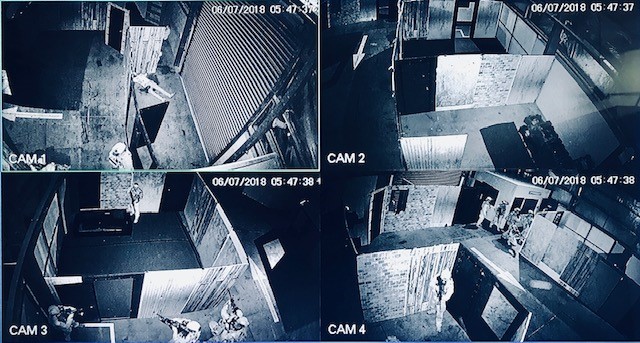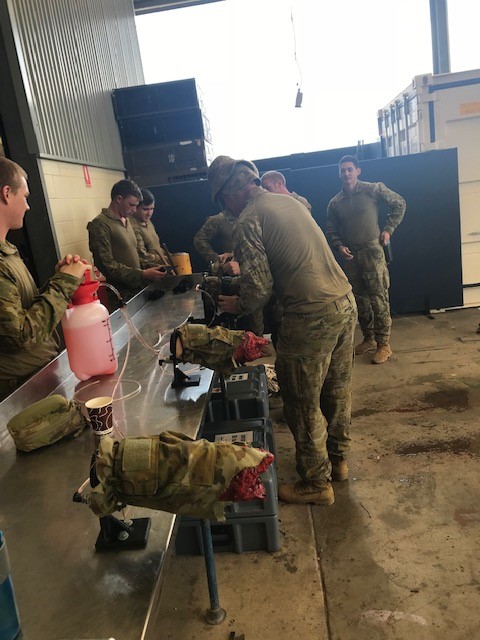'In the end, it is not about the ‘hardware’ it is about ‘software’. Amateurs talk about hardware or equipment, professionals talk about software or training mental readiness.' – Michael J. Asken, PH.D, The Warrior Mindset
The pre-dusk air is thick with moisture. Droplets of sweat run down your face. The weight of your body armour only adds to the heat and sweat pools between your back plate and cam shirt. Your helmet is an oven that is baking your head, and your gloves have been soaked through for hours. The hustle and bustle of a market can be heard. People are chattering, stall owners call to customers as they walk by, and as your senses attune to your surrounds you can hear the call to prayer faintly starting in the distance. None of this bothers you however, as you are focused on the de-brief points you received from the teacher in the After-Action Review Room, cemented into your consciousness after seeing your previous missions played back to you on screen.
Remember your combat breathing, visualise before you make entry, then as you start your quarter make sure your finger is on the trigger and your eyes are looking just over the top of the optic, hunting for the next target.
You breathe – in for four, hold for four, out for four, hold for four. You visualise making the perfect entry – straight to the corner then turn to clear the rest of the room. Your finger is on the trigger with your weapon on instant. You’re hunting. As you reach the door, a quick door assessment indicates its inward opening – you know the drill. So does the number two. You reach for the door handle and wrap your fingers around the door knob, your sweat soaked gloves slipping as you grasp the metal. You have to grip tighter as you confirm whether it is locked. It’s not, so you quietly turn the knob. You push the door open and prepare to start your quarter. The room is dark. In the dim light you can make out a couch and a television atop a wooden table. Happy it is clear, you hand the room off to your number two who conducts his quarter. He makes eye contact and indicates he is ready. You give the signal and make entry…
Welcome to The Yard.
The above scenario is not a description of a soldier on operations. Rather is a description of the immersion and depth of instruction a student experiences when they conduct training in The Yard. After nine months of dedication and hard work, The Yard – 1 RAR’s immersive combat training facility – is finally reaching completion and will soon be delivering training packages in Enhanced Combat Shooting (ECS), Urban Combat Clearance (UCC), Combat Trauma (CT), Light Urban Explosive Breaching (LUEB), Search and Hazard Reduction and Combat Signals in 2019.
The Yard, an idea born from the desire to make high-end, dynamic, accessible, productive combat behaviour/close combat training for 1 RAR and wider 3 Brigade (3 BDE) soldiers, has become a reality. The old Pioneer Platoon Warehouse has been transformed into an engrossing combat training facility utilising the science of how the brain works, how we learn, our response to stress and adult learning principles to underpin the training packages delivered.

The Yard consists of:
The Day Night Facility. As the name suggests, this is a warehouse sized facility that can simulate both day and night with the ability to completely black out the room. Inside are modular room packs set up to simulate a small street-scape. The rooms are fitted out with furniture – old couches, beds, computers and rugs – all with the ability to hide inert explosive devices in them. The room is equipped with directional speakers that allow the teachers to play different sound tracks based on the scenario and have multiple soundtracks playing at the same time. The warehouse also has 5 Closed Circuit TV (CCTV) cameras that record all the actions of the trainees as they progress through the scenarios for dynamic after action reviews (AAR).
The Non-Lethal Training Ammunition (NLTA) Area. This partitioned part of the outside courtyard is wrapped in Polybelt and contains 4 multi-room packs set up to allow for the practice of all drills taught in the UCC package. The Polybelt also allows for Airsoft scenarios to be conducted outside in a safe manner and, with the introduction of Man-Marking Munitions in 2019, it will enable these munitions to be fired within the confines of the Battalion. This area is equipped with breaching facades that allow pioneers to practice breaching tactics, techniques and procedures (TTP) and simulate breaching buildings. Again, CCTV cameras are set up to record all training.
The Urban Operations Training Area. This is the shipping container village built to replicate a small village in any part of the world. It consists of four containers with doors, windows and mouse holes cut into them. The containers have a series of walls, built by the 1 RAR Basic Pioneer Course, to replicate backyards and courtyards. The size of the area makes it complex and large enough for a Platoon sized force element to have difficulty clearing it.
The Combat Trauma Cell. This is where all Combat Trauma and dislocated call sign extended care packages are conducted. The Cell is equipped with high end training aids that replicate amputated limbs, gunshot wounds, femoral bleeds, and a moulage kit that allows for most wounds to be replicated.
The De-brief Room. All aspects of The Yard feeds back into the de-brief room. This is where the teachers of each package conduct live de-briefs with the trainees as footage from the CCTV camera system plays back onto two large screen TVs. The teachers can pause/play, play in slow time, rewind and zoom in on the play back whilst ensuring the trainees receive the most comprehensive AAR possible.

The Yard offers 3 BDE a series of packages that harness the training methodology introduced by the Enhanced Combat Shooting Course (ECSC). Each training package is developed and facilitated by the cells within The Yard – a dedicated group of junior non-commissioned officers (JNCOs) and privates (PTEs), identified for their proficiency in the respective skill sets. Importantly, subject matter experts from across Army and Special Operations Command (SOCOMD) have assisted in developing the packages so the teachers can ensure they are providing the most up-to-date techniques.
The packages seek to leverage the science of learning and how the brain works to ensure trainees assimilate the skills sets quickly and with minimal loss in the knowledge transfer. One example of this methodology is that teachers will only conduct lessons for a 20 minute period rather than a 40 – 50 minute period and provide regular breaks.[1] Additionally, the teachers understand that trainees are motivated by relevance and emotion in training. If the brain associates an experience with a positive emotion it is more likely to retain the experience – we retain the best and worst experiences.[2] This means that if the teachers create an environment charged with positive emotion, trainees respond to it in a positive way and retain the information better. The Yard is also a consequence free failure environment - when a trainee fails, they learn. This is an important concept that creates the positive environment, and more importantly, gives trainees confidence in the skills to progress. These concepts are vital and underpin the methodology within The Yard.
Whilst some may not see the benefit of this type of teaching methodology, the endorsements The Yard has received from all the trainees that have completed a package speak volumes. Anecdotally, when asked in the post-activity reviews what the best aspects of the training packages were, most trainees said it was the learning environment. This is important because the results that are being produced in 1 RAR soldiers are exceptional, and it is due primarily to the methodology being used.

Building the new training facility did not happen without learning lessons. Below is an outline of the most important lessons learnt whilst developing The Yard.
Building a network and support base: This is vital. The network created by The Yard started before the physical infrastructure was even in place. This required the team members to engage with people – SMEs in their respective field, civilians and military alike. One of the first groups The Yard team worked with was James Cook University. This relationship allowed The Yard to develop research into efficiency and skill retention during the ECSC. In addition, a strong network also produces a support base. It is vital that the message gets promoted as many times as possible, and, whenever possible, it is best to demonstrate the capability in person – people believe it when they see it in the flesh.
Cost and benefit: The Yard does not come without a cost. The Commanding Officer has had to post an entire team into The Yard consisting of four corporals, six PTEs and a platoon headquarters. This is a heavy cost to the Battalion, but the investment pays big dividends. Instead of having last-minute training being conducted at the section level whenever the training program allows, section commanders can have a dedicated training team allowing both the section and the section commander to be involved. This is an opportunity very rarely experienced. The same can be said for platoon commanders.
Engaging those that seek to use the facility: This lesson goes to the heart of 'Design Thinking' in that a product produced for a specific group of people must involve those people in the development. The team in The Yard discussed development ideas with those members of the Battalion that would use it. It also required the team to think about how they wanted to use the facility and design it in such a way to support training.
Disruptive thinking: In all innovations, ideas can challenge some people involved in the development process. This is a natural response to change. However, it is essential that the ideas are sold in such a way that they mitigate against the push back. Additionally, in order for innovation to be achieved, the innovators need to not only think outside the square, but the square needs to be broken all together. This has required the team to challenge assumptions, both their own and those around them, and ask why things are done in a certain way. This applies to not only the development of the facility, but also to the training and the approach for teaching trainees.
Determination and Perseverance: Finally, with all projects, the energy comes and goes, but there is a palpable reduction when things slow down. It is vital that this is recognised and pushed through. Efforts must be made to jump-start the project as soon as possible - find work that can be done when waiting for orders to arrive, review training or even conduct your own training. This keeps the team involved and makes them feel like they are pushing the project forward.
Implications for the future
The Yard presents an opportunity for the wider Army, and indeed the Australian Defence Force. The concept of an immersive combat training facility is not a new idea, but it is one that resonates with those that train for combat. It has been tested at 1 RAR and it works. The feedback received from everyone who has seen The Yard (from neighbouring 3 BDE units to Commander Forces Command) has been that this facility can revolutionise the way infantry battalions, combat brigades, reserve units and training schools teach, learn and progress. The training methodology, first introduced by SOCOMD during the first ECSC run at Majura, produces results. Not small improvements, but big leaps and bounds. Soldiers come to work and want to train given the positive experience training now has for them. These opportunities are available now and with a small cost, the benefit is vast.










However, the initiative isn’t without its challenges. The dedicated staff and infrastructure, while necessary, place a heavy burden on battalion resources—something that may limit scalability across the Army without additional support. The risk of layout familiarity also exists, which could be mitigated through frequent reconfiguration and integration of new threats. Most importantly, as modern warfare evolves—particularly with the widespread use of drones, loitering munitions, and ISR saturation seen in the Russo-Ukrainian War—The Yard will need to continually adapt its scenarios and TTPs. Urban warfare today demands more than just clearing rooms; it demands counter-drone awareness, electronic warfare resilience, and near-constant adaptation.
That said, The Yard provides a strong foundation and a replicable model. If resourced and evolved correctly, it has the potential to become the standard for combat training across the ADF.